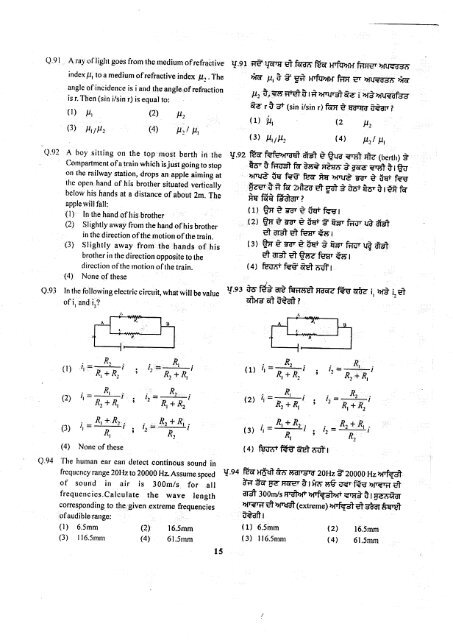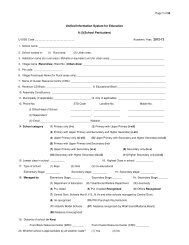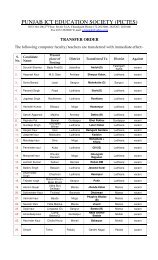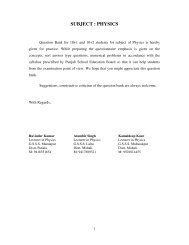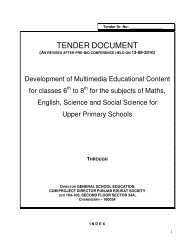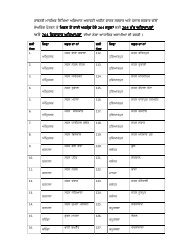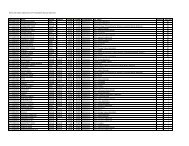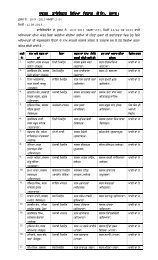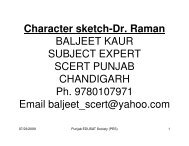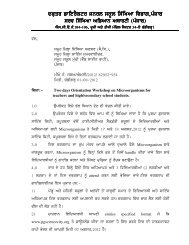Q 1 F't' tF' - SSA Punjab
Q 1 F't' tF' - SSA Punjab
Q 1 F't' tF' - SSA Punjab
You also want an ePaper? Increase the reach of your titles
YUMPU automatically turns print PDFs into web optimized ePapers that Google loves.
Q.9l A ra;, of light goes fronr the mediurn of refractive<br />
index p, to a nredium of refractiye index p" . The<br />
an$le of incidence is i and the angle of refraction<br />
is r. Then (sin i/sin r) is equal to:<br />
{t} ilr Q', ltz<br />
(3) t\/lt2 (4) F:/ltr<br />
Q.9? A boy sitring or: the rop mosr herth in the<br />
Comparrment ofa trairr which isjust going to stop<br />
on the railway station, dn:ps an apple aiming at<br />
the cpen hand of his brother situated vertically<br />
belorv his hands at a disrance of about 2m, The<br />
apple will fall:<br />
{ l) In the hand of his b,rother<br />
(2) Slightly away fronr the hand of his brother<br />
in the direction of the motion of the train.<br />
{3) liligfirly away from rhe hands of his<br />
brorher in the direction opposite to the<br />
direction ofthe rnotion of the train.<br />
(4) None of these<br />
Q.93 In the following electric circuit, rvhat will be value<br />
of i, and ir?<br />
{,91 r€'{qrs * fEra?t F-{ H.fqm{ fnnE,bru€rss<br />
rirc !, 3 3 EC Hrfirlro{ hr err a*rgoe:;r rird<br />
p, i, er ed t r * rru=fr d-e i *ri ryrrgsfurs<br />
*e r,t s' (sin iAin r) faF € Enrrair i€ar. i<br />
(L) ',t41<br />
(3) p,,pt<br />
{2 l"tz<br />
(4) il:tlt<br />
r{.ez fu feisorm'} # A Qrro e'r* *a luertn; *<br />
+6't ffi rdr ffi Fiffi ig-{eers} iirt}u<br />
4rnr3 ts H' fw Bs Drqre yil + tsi f.ig<br />
E''ee"3 fi fc zr$-a d ge i fu,t-a, i r €F. f{<br />
frq f*e H"br ?<br />
( 1) 9F i sa' t iw fssl<br />
(2) 9F S'gr + fu,. f EH'kd, ua f*<br />
ddd*fertur<br />
(3) ?T e ya'i fu- i E-J' frfl lrf ffi<br />
Et aEfr dgll-a fur'€rl<br />
(4) kalH'i'*nfrr<br />
i<br />
{.e3 A6 trt ae M HirEra Eril qhc i. arS. i-d<br />
drrafr i'#r ' t<br />
(l) ',=;ft;t<br />
. i,= {' ,<br />
'<br />
I &+&<br />
(2) tl<br />
. R,+R,.<br />
(3) ,' =l-,<br />
t<br />
(4) None of these<br />
;, - =-&-y R,+R,<br />
,,=s&,<br />
Q.94 'Ihe human ear can detect continous sound in<br />
frequcncy range 201-lz to 20000 Ha Assume.speed<br />
of sound in air is 300mls for all<br />
frequencies.Calcu late the wave lengrh<br />
corresponding to the given €xtreme frequencies<br />
ofaudible range:<br />
( l) 6.5rnnr<br />
{3) ll6.5mnr<br />
(2)<br />
(4)<br />
l6.5mm<br />
6l.5mm<br />
15<br />
.R,<br />
(1),'=}lE,<br />
(2) 'r<br />
=<br />
*j;,<br />
(3)l=ry,<br />
(4) fwrtf*€'a$aiifr<br />
. .R,<br />
. lr= i<br />
R,+R,<br />
.R"<br />
. f'= ' I<br />
' & R,+4<br />
. R,+R,<br />
. Ir=-/<br />
t'R"<br />
{.e4 k Sifr *ir rsrgs 20Hz ? 20000 Hz }rrksl<br />
tTT ge 1re rrcrs t rfm lr€ ue, F-g apgr;1g<br />
arS loonvs r-ert. Df.H,,{,


